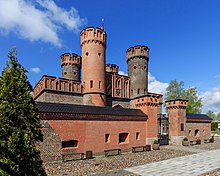Groß Friedrichsburg Fortress (Königsberg)
The fortress Groß Friedrichsburg was a citadel on the Pregel in front of the three Königsberg cities. It was never a city gate .
history
Located on the south bank of the Pregel, the fortress was assigned a special task - the sovereign safeguarding of the Holländer Baum shipping barrier . It had the same floor plan as the Spandau Citadel .
Koenigsberg
After the Königsberg uprising , the elector Friedrich Wilhelm came to the conclusion that his authority in Königsberg had to be represented by military means. The Friedrichsburg Fortress was built in 1658 and redesigned during the fortress construction after 1843 and architecturally adapted to the other fortress structures. It was originally designed in a star shape with the surrounding Pregel moat. It had only one entrance (from the west). Immanuel Kant liked to go for a walk on the western part of the trench edge of the fortress, part of the Philosophendamm .
The citadel was square in shape, the bastions at the corners were named with emerald , ruby , diamond and pearl . From 1780 to 1781 Ludwig Yorck von Wartenburg served a prison sentence here as a lieutenant for refusing to give orders. In the middle of the 19th century the Friedrichsburg became part of the second fortification ring around Königsberg. From then on it was no longer called the Citadel, but Fort Friedrichsburg. Around the same time, around 1852, the gate of the fort was built. With the exception of a few structural elements that have been changed over the decades, the Friedrichsburger Tor was given its current appearance. At the beginning of the 20th century it was found that the fort at that time was unsuitable for defending the city of Königsberg. The fort itself was handed over by the German Reich to the later Deutsche Reichsbahn in 1910 and demolished by them because it stood in the way of the expansion of the railway and the new construction of the freight station, and the moats were filled in. It was not involved in any combat operations until the Battle of Königsberg at the end of World War II. In 1945, towards the end of the Second World War, the gate was badly damaged by artillery .
A model of the fortress was exhibited in the Museum Stadt Königsberg and has been in the East Prussian State Museum in Lüneburg since its closure .
Kaliningrad
Above the portal you can still see the Fraktur inscription "Fort Friedrichsburg". Above it is the Prussian eagle. The top of the gate is adorned with a battlemented parapet. In the lower part there are casemates with loopholes. The gate portal is designed with different colored decorative bricks.
After the end of the war, the Friedrichsburger Tor fell into disrepair. So it was even close to the final demolition. However, this was prevented by a resolution of the Council of Ministers of the RSFSR in 1960, which declared the gate to be a monument. In the following years until the end of the Soviet Union in 1991 and thereafter it was used as a storage building and then stood there as an unused and abandoned ruin. Its secluded location on the closed freight station and the fact that it was used as a warehouse, has probably there before the final decay and demolition preserved. The restoration began in 2007. Although a reopening was planned for 2010, the restoration work could not be fully completed until 2011, as the work was delayed due to the great neglect of the gate, the sluggish funding from the Russian Ministry of Culture and the constant change of the executing companies . The work was carried out by specialists from Kaliningrad, St. Petersburg and Veliky Novgorod . In addition, the way to the gate, Porowaja Street, and the immediate vicinity of the gate were redesigned by the city administration. Furthermore, the construction of new pavilions is planned to accommodate various historical ship models. A viewing platform was set up on one of the four fortress towers. On May 17, 2011, the gate was opened as a branch of the Russian World Ocean Museum with an exhibition of objects from all parts of Russia under the title "The Resurrection of Ships", which is dedicated to Tsar Peter the Great. In the future, exhibitions on the history of Russian seafaring and the Russian navy are to be seen.
See also
literature
- Robert Albinus: Königsberg Lexicon. City and surroundings. Special edition. Flechsig, Würzburg 2002, ISBN 3-88189-441-1 .
- Richard Armstedt: history of the royal. Capital and residence city of Königsberg in Prussia. Hobbing & Büchle, Stuttgart 1899 ( German land and life in individual descriptions . 2, city stories). (Reprint: Melchior-Verlag, Wolfenbüttel 2006, ISBN 3-939102-70-9 ( Historical Library )).
- Fritz Gause : The history of the city of Königsberg in Prussia. 3 volumes. 2nd / 3rd supplemented edition. Böhlau, Cologne et al. 1996, ISBN 3-412-08896-X .
- Gunnar Strunz: Discover Königsberg. On the way between Memel and Haff. Trescher, Berlin 2006, ISBN 3-89794-071-X ( Trescher travel series ).
Individual evidence
- ↑ a b Ulrich Albinus: The gates of the city of Königsberg. Some of them survived World War II as well . Ostpreußenblatt 3/1983
Coordinates: 54 ° 42 ′ N , 20 ° 30 ′ E




